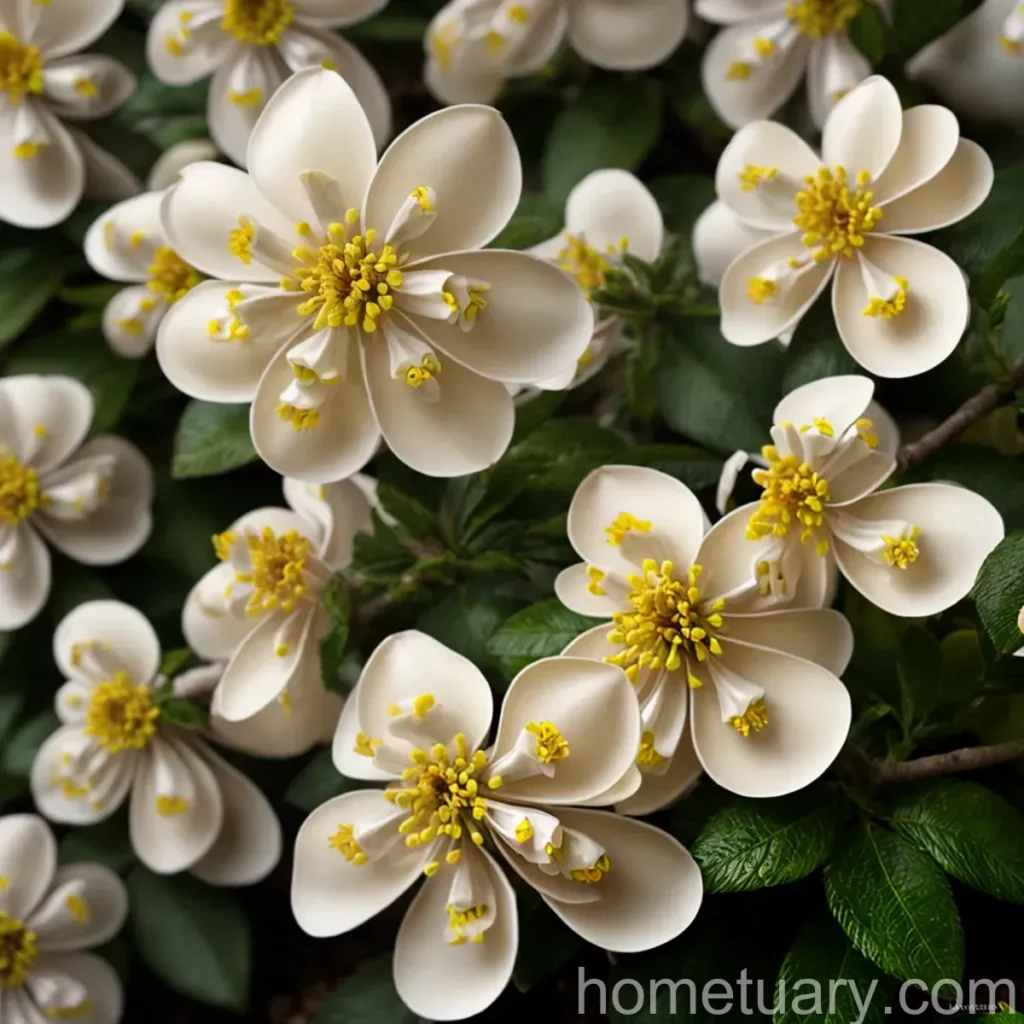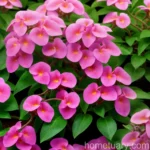The Marvelous Paperbush (Edgeworthia chrysantha ‘Snow Cream’)
The captivating beauty of paperbush, scientifically known as Edgeworthia chrysantha ‘Snow Cream,’ has been the subject of admiration for gardeners and plant enthusiasts for many years. This elegant shrub, prized for its fragrant white blooms and unique bark texture, is more than just a visually appealing addition to any landscape. In this comprehensive guide, we will explore the distinct characteristics of the paperbush, along with essential cultivation techniques, maintenance tips, and fascinating insights into this extraordinary plant.
What is Paperbush (Edgeworthia chrysantha ‘Snow Cream’)?
Paperbush (Edgeworthia chrysantha ‘Snow Cream’) is a deciduous flowering shrub belonging to the Thymelaeaceae family. Originally hailing from China, Japan, and the Himalayas, this plant has earned its popularity due to its remarkable ornamental qualities, including a delightful fragrance that fills the air during the late winter and early spring months. The common name “paperbush” is derived from the traditional use of its bark in paper production and weaving, particularly in Asia.
The ‘Snow Cream’ variety of Edgeworthia chrysantha is particularly renowned for its pristine white blooms, adding a touch of elegance to any garden or landscape. The intricate flowers bloom in clusters, creating a visually stunning display against the shrub’s dark green foliage. The enchanting scent of the blossoms further enriches the overall appeal of the paperbush.
Key Takeaways – Paperbush (Edgeworthia chrysantha ‘Snow Cream’)
Before delving into the specifics of paperbush care and cultivation, let’s briefly outline the essential characteristics and key points associated with this remarkable plant:
- Common Name: Paperbush (Edgeworthia chrysantha ‘Snow Cream’)
- Botanical Name: Edgeworthia chrysantha ‘Snow Cream’
- Family: Thymelaeaceae
- Origins: China, Japan, Himalayas
- Notable Features: Fragrant white blooms, unique bark texture, graceful habit
- Blooming Season: Late winter to early spring
- Hardiness Zone: 7-10
- Height: 4-6 feet
- Spread: 4-6 feet
- Sunlight: Partial shade to full sun
- Soil: Well-draining, fertile soil
- Water: Regular, consistent moisture
- Uses: Ornamental, landscape, cut flowers
With these key takeaways in mind, we can proceed to explore the comprehensive care and cultivation guidelines for paperbush, encompassing its cultural requirements, uses, water and sunlight preferences, fertilizer needs, soil considerations, pruning techniques, propagation methods, and more.
Cultural Requirements of Paperbush (Edgeworthia chrysantha ‘Snow Cream’)
Uses
The paperbush (Edgeworthia chrysantha ‘Snow Cream’) serves various essential purposes in a garden or landscape setting:
- Ornamental Feature: The elegant white blooms and distinctive bark texture make paperbush a favored ornamental specimen, adding aesthetic value to any outdoor space.
- Fragrant Cut Flowers: The blossoms of paperbush are highly prized for their delightful fragrance, making them a sought-after choice for indoor floral arrangements and bouquets.
Water
Establishing and maintaining appropriate moisture levels is crucial for the health and vitality of paperbush:
- Watering Needs: Paperbush thrives in consistently moist soil, especially during the growing season. Adequate watering is essential, particularly during dry spells, to ensure optimal growth and flowering.
Sunlight
Providing the right balance of sunlight is vital for the wellbeing of paperbush:
- Light Requirements: While paperbush tolerates partial shade, it generally prefers locations with partial to full sunlight. Positioning the shrub in a spot that receives adequate light will encourage robust growth and profuse flowering.
Fertilizer
Supplementing with appropriate nutrients supports the vigor and blooming capacity of paperbush:
- Fertilization: Applying a balanced, slow-release fertilizer in early spring can promote healthy growth and enhance the flowering performance of the shrub. Additionally, a light top dressing of compost can further enrich the soil and bolster the overall health of the plant.
Soil
Selecting the right soil type and ensuring proper drainage are essential for paperbush cultivation:
- Soil Type: Paperbush thrives in well-draining, fertile soil with a slightly acidic to neutral pH. Loamy soil enriched with organic matter is ideal for supporting the plant’s growth and development.
Pruning
Applying appropriate pruning practices helps maintain the form and vitality of paperbush:
- Pruning Guidelines: Pruning should be performed after the flowering period to shape the shrub and remove any dead or damaged branches. This practice not only enhances the plant’s appearance but also stimulates healthy regrowth and flowering in the following season.
Propagation
Expanding your paperbush collection can be achieved through effective propagation techniques:
- Propagation Methods: Paperbush can be propagated through softwood cuttings or layering. Softwood cuttings taken in early summer can root relatively quickly and develop into new plants. Layering, particularly air layering, is another method that can yield successful results in propagating paperbush.
Container Popularity
The compact size and ornamental appeal of paperbush make it well-suited for container cultivation:
- Container Planting: Paperbush can thrive in containers, allowing for versatility in placement and a captivating display on patios, decks, or outdoor living spaces. When grown in containers, regular watering and a well-balanced potting mix are essential for supporting the plant’s growth requirements.
Common Diseases
While generally hardy, paperbush may be susceptible to certain diseases that can impact its overall health and vigor:
- Disease Susceptibility: Paperbush may experience issues such as leaf spot diseases, powdery mildew, or dieback in conditions of poor air circulation and excessive moisture. Monitoring the plant for any signs of disease and addressing them promptly is crucial for maintaining its wellbeing.
Disease Diagnosis
Identifying potential diseases and addressing them effectively is vital for preserving the health of paperbush:
- Diagnostic Measures: Regularly inspecting the foliage for any abnormal discoloration, spots, or signs of wilting can aid in early disease detection. Consulting with a plant health specialist or horticulturist can provide valuable insights for accurate diagnosis and targeted treatment.
Common Pests
While generally resilient, paperbush may encounter pests that can affect its growth and vitality:
- Pest Concerns: Aphids, scale insects, and spider mites are among the common pests that may target paperbush. Vigilant monitoring and immediate intervention, such as through insecticidal soap or horticultural oil applications, can help manage pest infestations effectively.
Botanist’s Tips
Insights from botanical experts can offer valuable guidance for successful paperbush cultivation:
- Expert Advice: Botanists recommend providing adequate winter protection, especially in colder regions, to safeguard paperbush from potential frost damage. Mulching around the base of the shrub can offer insulation and protect the root system during periods of extreme cold.
Fun Facts
Uncover intriguing and delightful facts about paperbush that showcase its unique appeal:
- Historical Significance: The bark of paperbush has been used for centuries in traditional paper and textile production in several Asian countries, exemplifying its cultural and historical significance beyond its ornamental value.
- Aromatic Splendor: The enchanting fragrance of paperbush blossoms has been likened to a blend of honey and citrus, adding a delightful sensory dimension to its allure.
Links to External Resources
For further in-depth information on paperbush and its cultivation, the following external resources are highly recommended:
- Royal Horticultural Society – Edgeworthia chrysantha
- Missouri Botanical Garden – Edgeworthia chrysantha ‘Snow Cream’
- University of Georgia Extension – Paperbush for Southern Landscapes
In this extensive guide, we’ve explored the fascinating world of paperbush (Edgeworthia chrysantha ‘Snow Cream’), from its cultural requirements and uses to intriguing insights and expert recommendations for optimal care. Whether you’re seeking to enhance your garden with its stunning blooms or interested in the historical and botanical significance of this exceptional shrub, paperbush continues to captivate with its charm and allure.
For gardeners and plant enthusiasts alike, the timeless beauty and aromatic splendor of paperbush remain an enduring source of joy and fascination, making it a cherished addition to any outdoor space.
Remember to embrace the guidance and resources provided to nurture your paperbush to its full potential, and delight in the exquisite beauty it brings to your garden each year.
Happy gardening!
References
- Royal Horticultural Society. “Edgeworthia chrysantha.” Available: https://www.rhs.org.uk
- Missouri Botanical Garden. “Edgeworthia chrysantha ‘Snow Cream’.” Available: https://www.missouribotanicalgarden.org
- University of Georgia Extension. “Paperbush for Southern Landscapes.” Available: https://extension.uga.edu















